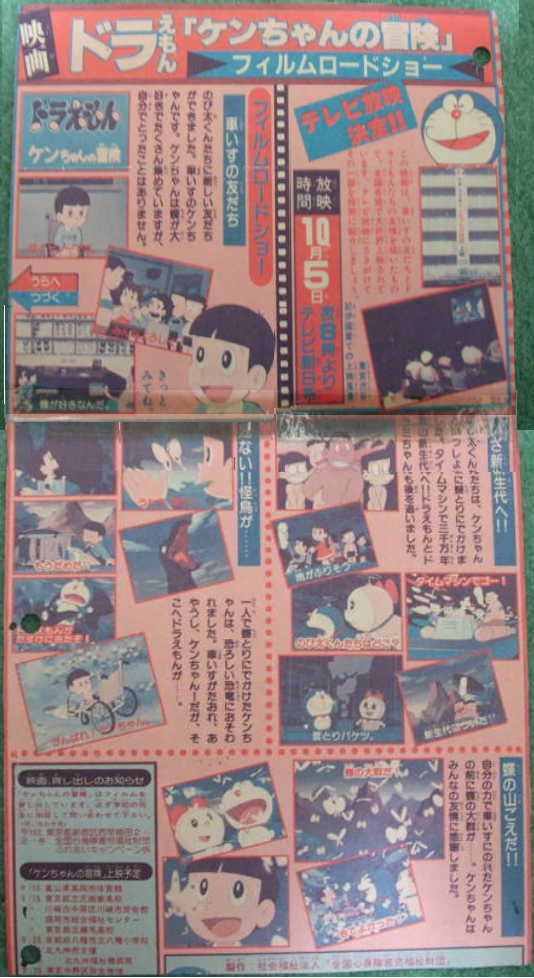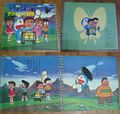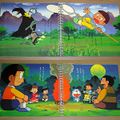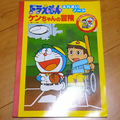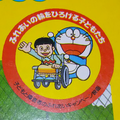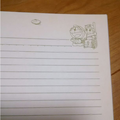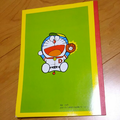Doraemon: Ken-chan's Adventure (partially found anime short film/TV special; 1980-1981): Difference between revisions
No edit summary |
No edit summary |
||
| Line 5: | Line 5: | ||
|status=<span style="color:red;">'''Lost'''</span> | |status=<span style="color:red;">'''Lost'''</span> | ||
}} | }} | ||
'''Doraemon''' is a popular and long-running anime series based on the manga of the same name by Fujiko F. Fujio. Its best-known adaptation originally ran from April 2, 1979 to March 18, 2005, while a reboot, that began airing a month after the first series' conclusion, is still airing to this day. A total of 38 feature-length Doraemon movies have been released, as well as numerous short films. | '''Doraemon''' is a popular and long-running anime series based on the manga of the same name by Fujiko F. Fujio. Its best-known adaptation originally ran from April 2, 1979, to March 18, 2005, while a reboot, that began airing a month after the first series' conclusion, is still airing to this day. A total of 38 feature-length Doraemon movies have been released, as well as numerous short films. | ||
One of these short films, titled "Ken-chan's Adventure", was a movie produced by the Welfare Foundation for the Disabled and Welfare of Japan, was screened in 1980 and 1981 for the International Year of the Disabled Persons in 1981, before being televised in October 1981. It was screened until the end of the century across Japan, and the starring guest character Ken-chan was the mascot of the Welfare Foundation for the Disabled and Welfare of Japan for a time. Oyama Nobuyo, who served as Doraemon's voice actor at the time, said that he learned how to communicate with the disabled in a way that he had not known before thanks to the special, and that it became an unforgettable work. He wanted the special to be rebroadcast on television, although that opportunity has not been given. Many viewers recall how blessed they were with the opportunity to see this film. It was later released as a picture book with Braille printing for the blind, however much of the story is left out. It plays a role like a learning tool to teach how children with disabilities and children without disabilities can get along with each other. The book may have come with a handkerchief for the disabled. The book was not sold normally, but instead the book had been distributed to the Toka Museum and welfare facilities, as well as in libraries, community centers, school facilities, etc. A notebook with illustrations based on the short film special was also released. | One of these short films, titled "Ken-chan's Adventure", was a movie produced by the Welfare Foundation for the Disabled and Welfare of Japan, was screened in 1980 and 1981 for the International Year of the Disabled Persons in 1981, before being televised in October 1981. It was screened until the end of the century across Japan, and the starring guest character Ken-chan was the mascot of the Welfare Foundation for the Disabled and Welfare of Japan for a time. Oyama Nobuyo, who served as Doraemon's voice actor at the time, said that he learned how to communicate with the disabled in a way that he had not known before thanks to the special, and that it became an unforgettable work. He wanted the special to be rebroadcast on television, although that opportunity has not been given. Many viewers recall how blessed they were with the opportunity to see this film. It was later released as a picture book with Braille printing for the blind, however much of the story is left out. It plays a role like a learning tool to teach how children with disabilities and children without disabilities can get along with each other. The book may have come with a handkerchief for the disabled. The book was not sold normally, but instead, the book had been distributed to the Toka Museum and welfare facilities, as well as in libraries, community centers, school facilities, etc. A notebook with illustrations based on the short film special was also released. | ||
===Story=== | ===Story=== | ||
A disabled boy in a wheelchair named Ken Ikoma is transferred to the class of Nobita Nobi, who loves to collect butterflies. However, due to his disability, the only butterflies he has ever collected were bought at shops. Ken wishes to catch a butterfly on his own, with his own butterfly net and hands. Nobita sympathizes with Ken, so with Doraemon and his friends, they travel back in time to the | A disabled boy in a wheelchair named Ken Ikoma is transferred to the class of Nobita Nobi, who loves to collect butterflies. However, due to his disability, the only butterflies he has ever collected were bought at shops. Ken wishes to catch a butterfly on his own, with his own butterfly net and hands. Nobita sympathizes with Ken, so with Doraemon and his friends, they travel back in time to the Cenozoic era, 30,000,000 years ago, to capture butterflies, but somehow a dinosaur appears there (despite being extinct 30,000,000 years ago), and the wheelchair collapses. Ken will have to return to the wheelchair by himself but is able to briefly stand on his own to catch the butterflies, with the help of his friends. Many ancient butterflies then appear, and Ken catches them by himself. He was happy and thanked his new friends for the experience. | ||
===Staff=== | ===Staff=== | ||
Production: Social Welfare Corporation National Welfare Foundation for Physically and Mentally Handicapped | Production: Social Welfare Corporation National Welfare Foundation for Physically and Mentally Handicapped | ||
Production cooperation: Fujiko Studio , Shin-Ei Video , | Production cooperation: Fujiko Studio, Shin-Ei Video, Shogakukan, TV Asahi | ||
Director / director: Hiraga elder | Director/director: Hiraga elder | ||
Screenplay: Koichi Mizuide | Screenplay: Koichi Mizuide | ||
| Line 25: | Line 25: | ||
Drawing: Eiichi Nakamura | Drawing: Eiichi Nakamura | ||
Film cooperation: Tokyo Development | Film cooperation: Tokyo Development Office | ||
Film print aid: Japan Lottery Association | Film print aid: Japan Lottery Association | ||
| Line 47: | Line 47: | ||
Kenchanbook12.jpg|Another page from the book. | Kenchanbook12.jpg|Another page from the book. | ||
Kenchanbook13.jpg|Copyright info on the back of the book, and a message in Braille. | Kenchanbook13.jpg|Copyright info on the back of the book, and a message in Braille. | ||
Kenchanbook14.jpg|High quality view of the back of the book. | Kenchanbook14.jpg| High-quality view of the back of the book. | ||
Kenchannotebook.png|The cover to the notebook, featuring an illustration of Ken playing baseball with the help of Doraemon. | Kenchannotebook.png|The cover to the notebook, featuring an illustration of Ken playing baseball with the help of Doraemon. | ||
Kenchannotebook2.png|An emblem on the notebook's cover, showing the promotion of the disability. | Kenchannotebook2.png|An emblem on the notebook's cover, showing the promotion of the disability. | ||
| Line 53: | Line 53: | ||
Kenchannotebook4.png|Illustration on the back cover of the notebook. | Kenchannotebook4.png|Illustration on the back cover of the notebook. | ||
</gallery> | </gallery> | ||
==External | ==External Link== | ||
*[https://ja.wikipedia.org/wiki/%E3%83%89%E3%83%A9%E3%81%88%E3%82%82%E3%82%93_%E3%82%B1%E3%83%B3%E3%81%A1%E3%82%83%E3%82%93%E3%81%AE%E5%86%92%E9%99%BA Japanese Wikipedia article on the special.] | *[https://ja.wikipedia.org/wiki/%E3%83%89%E3%83%A9%E3%81%88%E3%82%82%E3%82%93_%E3%82%B1%E3%83%B3%E3%81%A1%E3%82%83%E3%82%93%E3%81%AE%E5%86%92%E9%99%BA Japanese Wikipedia article on the special.] | ||
===References=== | ===References=== | ||
[http://genshiohajiki.hatenablog.com/entry/2017/01/21/040844 Blog post about the book.] | *[http://genshiohajiki.hatenablog.com/entry/2017/01/21/040844 Blog post about the book.] | ||
*[https://chunpomhobby.hatenadiary.jp/entry/2018/04/22/115645 Review of the book.] | |||
*[https://comic.5ch.net/test/read.cgi/ranime/1035083107/ 5chan thread of members recalling the special.] | |||
[[Category:Lost animation]] | |||
[[Category:Lost films]] | |||
[[Category:Lost TV]] | |||
[[Category:Lost animation]] [[Category:Lost | |||
Revision as of 19:15, 22 July 2018
Doraemon is a popular and long-running anime series based on the manga of the same name by Fujiko F. Fujio. Its best-known adaptation originally ran from April 2, 1979, to March 18, 2005, while a reboot, that began airing a month after the first series' conclusion, is still airing to this day. A total of 38 feature-length Doraemon movies have been released, as well as numerous short films.
One of these short films, titled "Ken-chan's Adventure", was a movie produced by the Welfare Foundation for the Disabled and Welfare of Japan, was screened in 1980 and 1981 for the International Year of the Disabled Persons in 1981, before being televised in October 1981. It was screened until the end of the century across Japan, and the starring guest character Ken-chan was the mascot of the Welfare Foundation for the Disabled and Welfare of Japan for a time. Oyama Nobuyo, who served as Doraemon's voice actor at the time, said that he learned how to communicate with the disabled in a way that he had not known before thanks to the special, and that it became an unforgettable work. He wanted the special to be rebroadcast on television, although that opportunity has not been given. Many viewers recall how blessed they were with the opportunity to see this film. It was later released as a picture book with Braille printing for the blind, however much of the story is left out. It plays a role like a learning tool to teach how children with disabilities and children without disabilities can get along with each other. The book may have come with a handkerchief for the disabled. The book was not sold normally, but instead, the book had been distributed to the Toka Museum and welfare facilities, as well as in libraries, community centers, school facilities, etc. A notebook with illustrations based on the short film special was also released.
Story
A disabled boy in a wheelchair named Ken Ikoma is transferred to the class of Nobita Nobi, who loves to collect butterflies. However, due to his disability, the only butterflies he has ever collected were bought at shops. Ken wishes to catch a butterfly on his own, with his own butterfly net and hands. Nobita sympathizes with Ken, so with Doraemon and his friends, they travel back in time to the Cenozoic era, 30,000,000 years ago, to capture butterflies, but somehow a dinosaur appears there (despite being extinct 30,000,000 years ago), and the wheelchair collapses. Ken will have to return to the wheelchair by himself but is able to briefly stand on his own to catch the butterflies, with the help of his friends. Many ancient butterflies then appear, and Ken catches them by himself. He was happy and thanked his new friends for the experience.
Staff
Production: Social Welfare Corporation National Welfare Foundation for Physically and Mentally Handicapped
Production cooperation: Fujiko Studio, Shin-Ei Video, Shogakukan, TV Asahi
Director/director: Hiraga elder
Screenplay: Koichi Mizuide
Music: Shunsuke Kikuchi
Drawing: Eiichi Nakamura
Film cooperation: Tokyo Development Office
Film print aid: Japan Lottery Association
